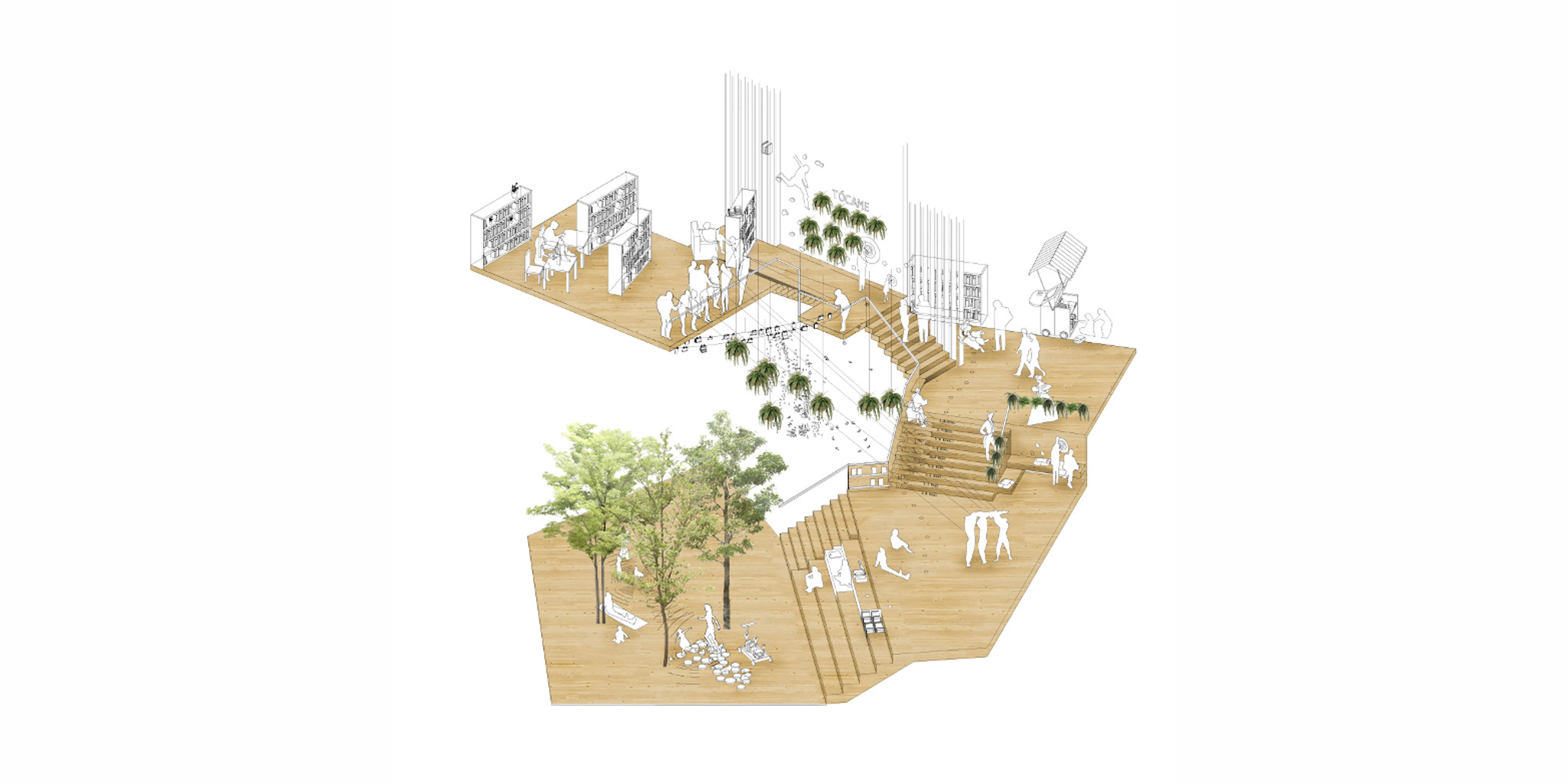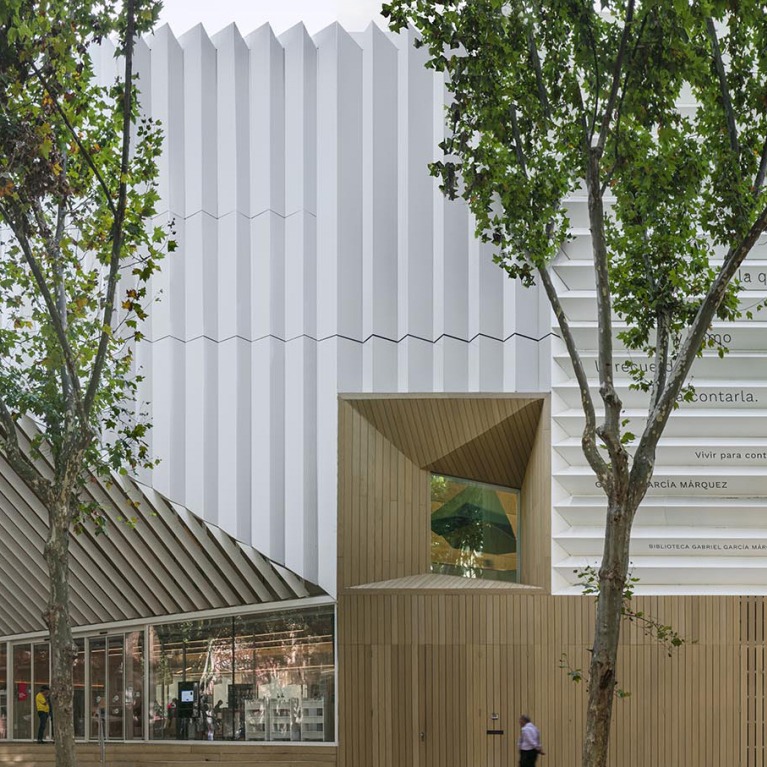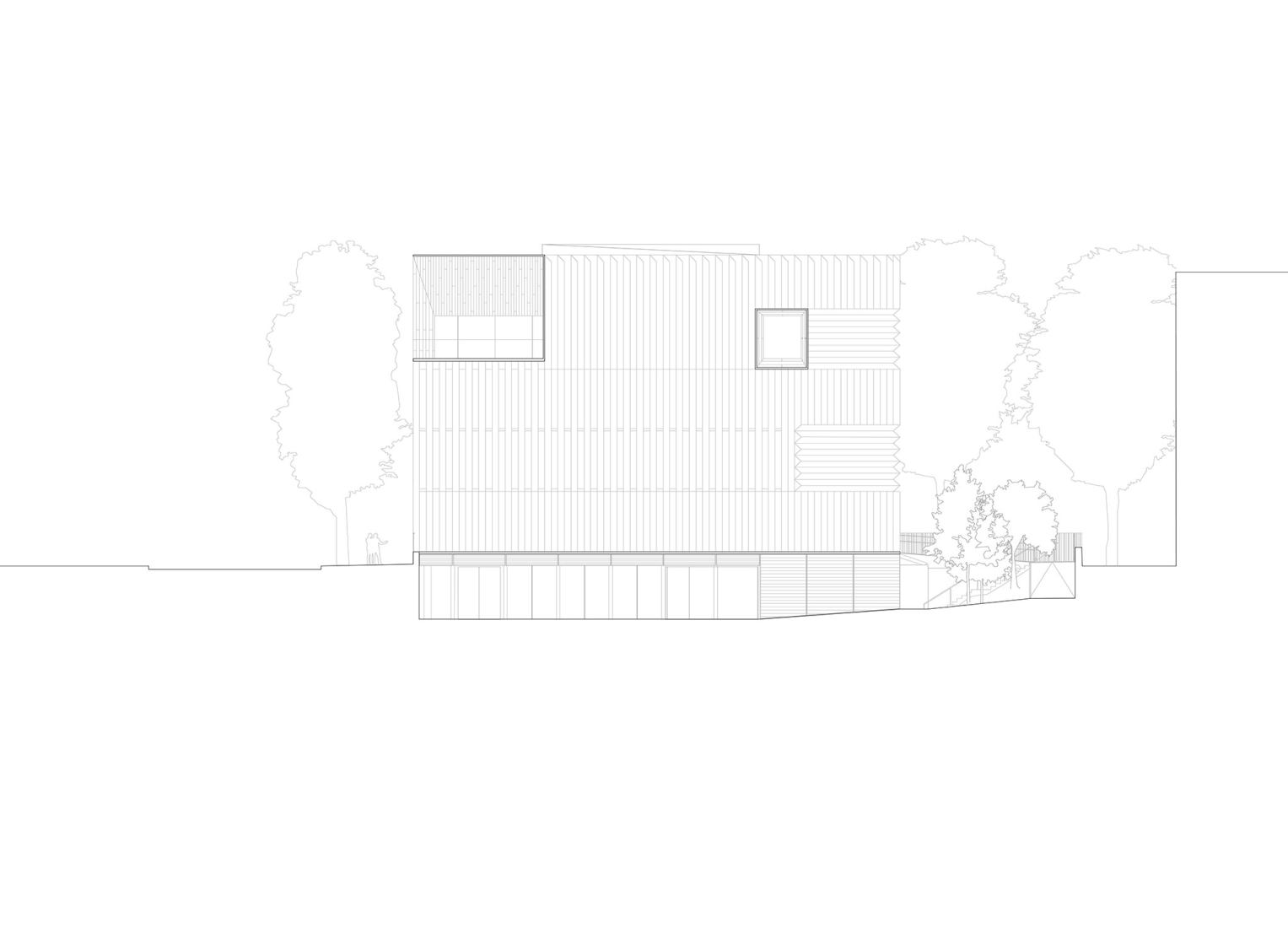A social and urban dialogue crystallized in an attractive and friendly building built with a wooden structure that helps to reduce the ecological footprint, reduce carbon emissions and execution times thanks to the prefabrication of its components. Outside, the skin is a constant that surrounds the five facades of the building, referring to a system of folds in the form of origami sheets that remember to bookshelves, but also serve to generate a ventilated roof that facilitates thermal control.
Inside, the entire volume orbits around its central void, a natural light connector, a visual and programmatic activator of all the spaces, flows and connections of its occupants, the vast majority of the residents of the neighbourhood. A space that also functions as a "solar chimney", a particularly effective resource to activate air circulation according to the outside climate, a way of natural ventilation, for better passive sustainability performance.
The combination of the wooden structure with steel elements has allowed large spans that have allowed the creation of large and fantastic interior spaces, which make the visit and stay attractive to interact with books in the best reading conditions.

Gabriel García Márquez Library by SUMA Arquitectura. Photograph by Jesús Granada.

Gabriel García Márquez Library by SUMA Arquitectura. Photograph by Jesús Granada.
Project description by SUMA Arquitectura
LOCATION
Gabriel García Márquez Library is located inside a dense urban node of Barcelona city, and it is precisely this context that causes the geometry of the building adapting it to its surrounding conditions, replicating the CHAFLÁN, a typical urban resource of Barcelona that is constantly found in the environment of this metropolis.
The building appears as a sculptural solid, seated on an elevated plaza that allows fluid pedestrian circulation through the cultural axis of the neighbourhood. The library rises in a cantilever over the open area, creating a fortified plaza delimited on the other side by the existing magnificent trees. Along the solid white, four bay windows open up, focusing the views and directing the gaze towards the great attractors of the surroundings. These cutouts allow the comfort and cosy atmosphere that develops inside the library, thanks to the wood that brings warmth to the whole building with a great aesthetic appeal. This feeling is expressed outwardly, being integrated with the urbanism of Barcelona.
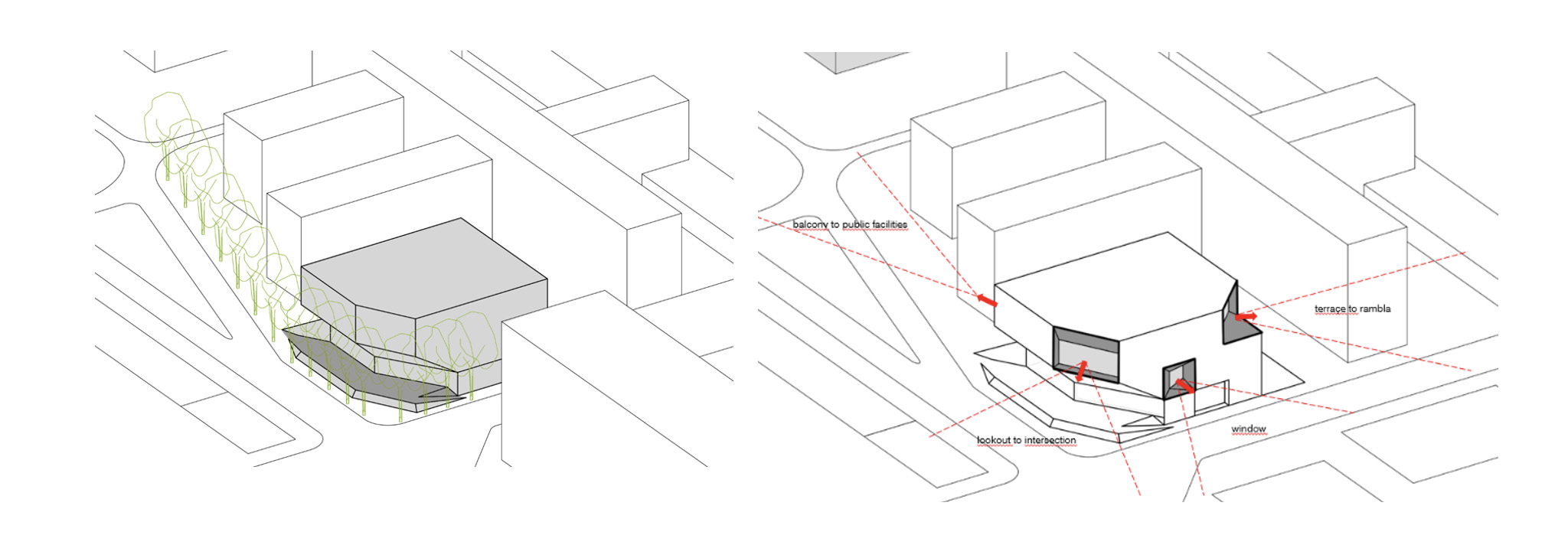
SUSTAINABILITY
The building resembles an open book pile with folded and perforated sheets. Each "book" is created due to a dense structure of wood panels, oriented in different directions. Not only the structural requirements define each direction, but also the lighting conditions of the space, its character, the functional program, and its urban links.
This wood structure provides a series of innovative and attractive benefits that make it an ideal material to develop our architectural vision, increasing the sustainability of the project by the reduction of carbon footprint and greenhouse gas emissions and speeding up the construction process thanks to industrialization and prefabrication, enabling the project to be successful in terms of time and costs.

However, it not only improves the immediate urban environment where it sits but also the forests from which this wood is supplied (FSC or PEFC-certified forests). These forests are managed in an environmentally, socially beneficial and economically viable manner, being continuously renewed and ensuring that no damage is done to the surrounding environment, or the native flora and fauna. In addition to forming a natural ecological habitat, these forests are an important carbon Sink by filtering CO₂ from the air and absorbing it in the tree biomass. Using these trees, when they have reached maturity and their rate of carbon sequestration from the atmosphere slows down, means that the wood produced acts as a carbon store while giving the forest the opportunity to regenerate and produce new biomass, acting as a new carbon sink. Moreover, wood is a renewable and recyclable material, which ultimately closes its sustainable life cycle.
But not only has wood been introduced as a circular material, all the envelope material in turn has a defined cycling pathway. The composites formed by polyurethane resins and fiberglass that shape the facade slats, when their useful life in the building is over, can be reused, repaired, or recycled in the most convenient way allowing them to preserve more value for the next use.
All this gives rise to a new paradigm of circular construction that takes into account the environmental and social externalities that generate, incorporating them into the equation and into the calculation of the total cost of resources, avoiding the consequences of the inefficient and unsustainable current system of linear construction, among which are the depletion of the planet's biocapacity. In short, the building is part of a new production and consumption model where resources and materials are permanently recycled and waste is minimized to the maximum, thus extending the life cycle of the products.
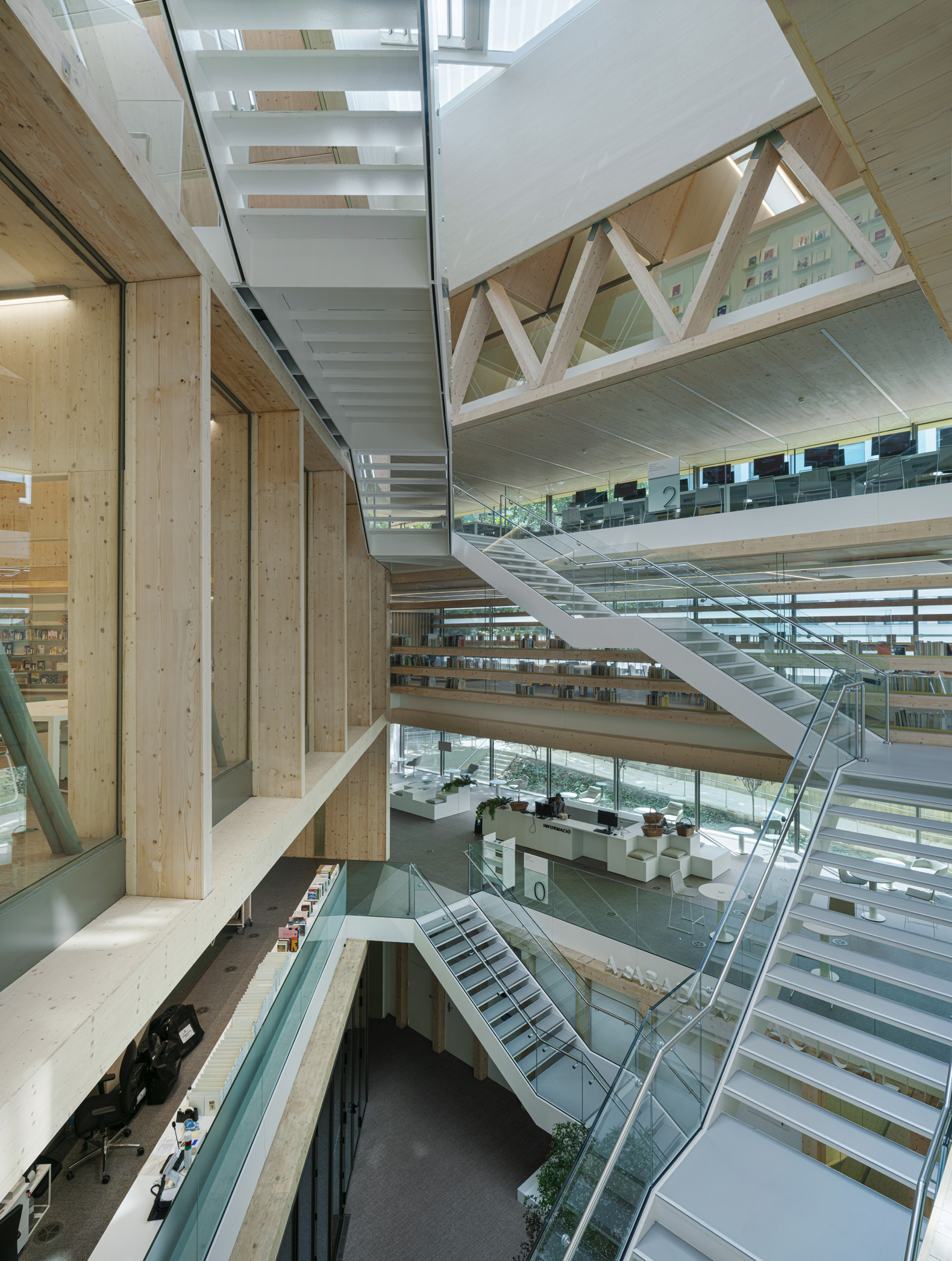
Gabriel García Márquez Library by SUMA Arquitectura. Photograph by Jesús Granada.
In addition, multiple environmental design strategies have been incorporated. The library is organized around a large triangular patio that connects all program uses to the main staircase. This large void brings NATURAL light into the heart of the library improving its lighting conditions and acting as a solar chimney, a form of passive building design particularly effective in hot and humid environments, which absorbs solar radiation by heating the air inside, which rises and ventilates at the top, creating air circulation as a method of natural ventilation.
It also incorporates in its design other sustainable strategies, helping the project to acquire LEED Gold certification, such as adequate insulation and a correct façade glazing system and shading orientation, providing great hygrothermal comfort, thanks to the natural insulation capacity of wood, the ventilated façade and roof, which reduces thermal transmittance, saving energy; the use of solar energy by integrating a system of photovoltaic panels placed on the roof; and the reuse of rainwater, collecting rainwater in a storage tank, in order to distribute it to maintain the water requirements of the building's vegetation, imitating the natural water cycle and reducing the possibility of erosion, overflow or damage to infrastructure, resulting from the urbanization of the natural environment.
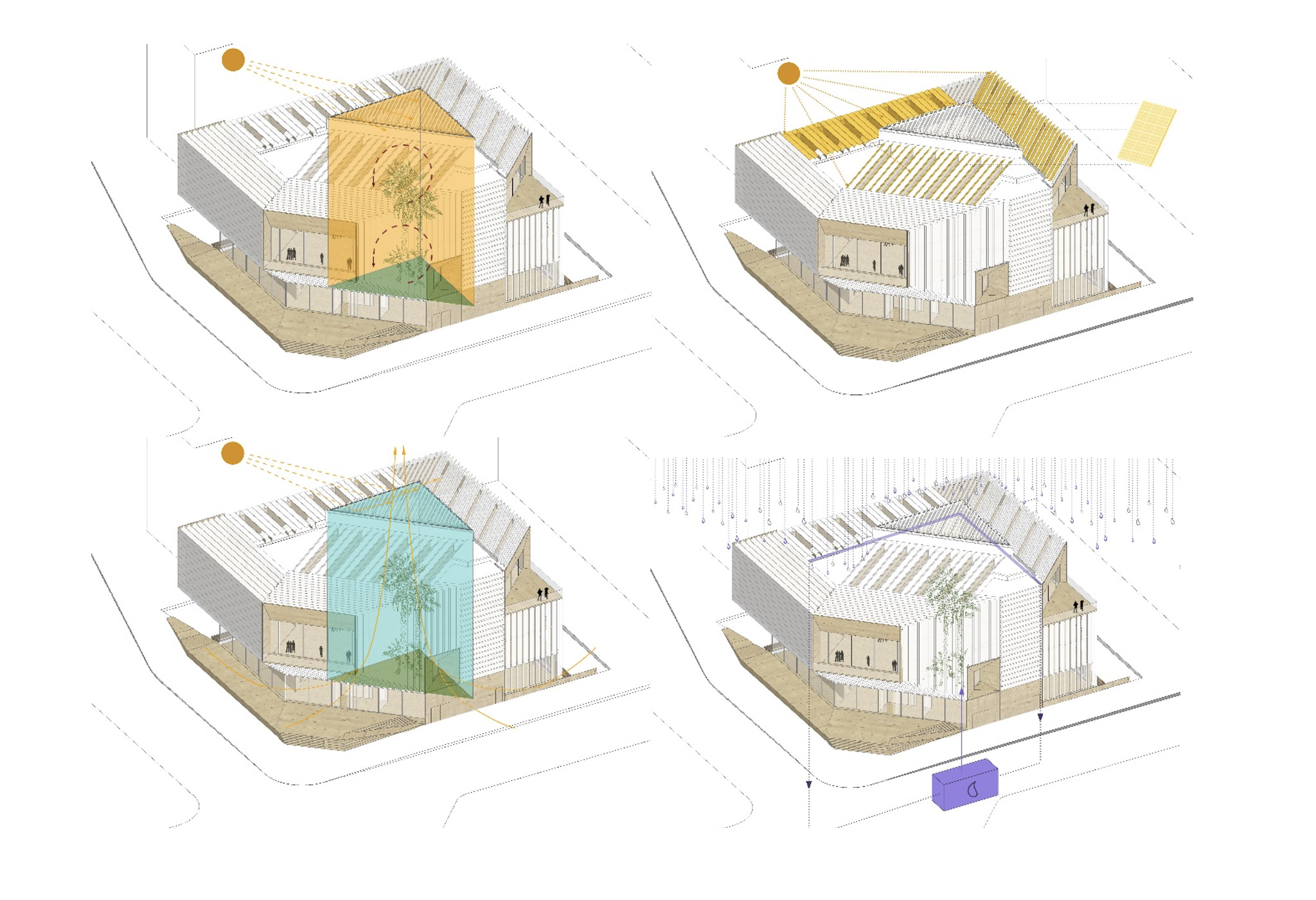
ECOSYSTEMIC STRUCTURE
The structure presents three vertical cross-laminated timber cores, around which the different areas of the library are efficiently arranged. Two of these cores are triangular in shape and include stairways and elevators, which are located in juxtaposition to the interior courtyard. The third core, square in shape, encloses the restrooms and storage areas.
Along these vertical cores, two clearly different spatial typologies are alternately developed and visibly defined by their function. First, the enclosed spaces, with a dense mixed structure of wood and steel oriented according to lighting and view conditions. These spaces enclosure the most demanding acoustic activities, such as the multipurpose room, radio, group work areas, children's areas, internal work areas and laboratories. Secondly, the open spaces, where most of the structure disappears, provide a sensation of amplitude and lightness that leaves clearer areas for the development of the main program, such as consultation, reading and study areas. These huge spans without intermediate supports are achieved through the establishment of a hybrid spatial truss system, where CLT panels used as slabs form the upper and lower chord of the three-dimensional structure and GLT pillars as vertical posts are interconnected, both connected by diagonal steel suspenders that complete the Pratt truss system. This dense hybrid system of wood and steel structure allows the level immediately below to unfold as a large-scale open space that can incorporate more social and flexible multidisciplinary functional programs.
At SUMA we assume that structures are not a separate problem from the building. Structures are not only governed by the laws of physics but are also intimately related to living creatures to form a whole organism. Structure for us is not just a matter of solving the load requirements of the building with the minimum amount of matter. It is not just a matter of addressing global agendas by choosing the right materials (carbon footprint, material life cycles, etc.). Structures belong to a complex ecosystem that must be approached from a holistic and relational point of view.

This idea forces us to design and explore structural systems with the strength and topological ductility necessary to satisfy needs of all kinds, starting with questions of space, form and material, questions of fabrication, transportation, assembly and concerns even beyond that.
Thus, the wood structure of the Gabriel García Márquez Library not only solves the transfer of vertical loads to the foundations but also collects and responds to the requirements of the functionality program, the insertion of natural light in all spaces, the vector of visual orientation, the haptic factor and several other issues that make this built complex an ecosystemic structure.
SPACE-QUALIFYING CONSTRUCTION
All the CLT panels required for the floor slabs, the vertical communication and service cores, the beams and the roof chimneys that enclose the skylights in the main areas were prefabricated in spruce wood. Including inside the factory the cut-outs, trimming, milling and machining necessary to incorporate the lighting, the installations, the steel technification by means of anchor plates, spindles, bushings and profiles, the placement of hidden rebates and glazing beads for the glass partitions and the attachment of fire extinguishing equipment, such as the smoke curtains that close the main patio in case of emergency.
When defining the elements that make up the structural wood model, it was necessary to differentiate them according to their structural behaviour and architectural requirements, in CLT cross-laminated timber or GLT laminated timber. We developed a manufacturing model in which it was necessary to control panel by panel the composition of layers and their visible faces. Each element was individually numbered and the type of sawn timber to be used, the total thickness of the panel in mm, the number of layers, the thickness of each layer and the direction of the boards on the exposed surface face were indicated.

The structure and its constructive definition DEFINES AND QUALIFIES THE SPACE without apparent tectonic efforts and integrate the program, the envelope and the furniture of each ecosystem of the library. All the joints, connections and assemblies of the building have been designed, understanding the project as a great work of cabinetmaking, where hidden joints are encouraged, without hardware in sight. This process increases the feeling of lightness and lightness of the building, resulting in a piece of presence as calm and light as permeable and luminous.
The envelope folds like origami sheets to externalize the original idea of stacked books. The modulation and orientation of the structure are densified to generate the folded sheets of books, which in turn, act as solar and visual control. Even on the roof, the envelope is folded and works as a fifth facade, generating a ventilated roof for thermal control.
This envelope is resolved with large prefabricated fibreglass dihedral-shaped pieces for the opaque parts of the facade and a triangular section for the louvres.

PIONEER PROGRAM - ECOSYSTEMIC DESIGN
During the project execution, we proposed from our studio the development of a pioneering program to implement inside the Gabriel García Márquez Library with the full involvement of the Consortium of Libraries.
In SUMA we understand that libraries are the paradigm of public space, which have become catalysts and social condensers. From our point of view, their relevance is not based on the programs and activities they host and could occur anywhere else, but on their unique space intensity, on their qualities as an ecosystem. In this way, we assume that the overall architecture of the library (the structure, the façade, etc.) is directly related to the furniture, the program, the collection and the users.
Multidisciplinary teams have been involved in this redefinition of the library program, from the specialized library staff, technicians, engineers, and acoustic consultants to the users themselves and neighbourhood representatives, scenographers, etc. We are not talking about social engineering, but about having extreme sensibility when working with our built environment. We are talking about a reflection that affects not only libraries but the public spaces on which we build our society. It is a matter of reaching a new consensus in each case in which architecture, collection, activities, users and environment form a cohesive network; a new ecosystem.
The architectural program is intense and dynamic because it acts as a true social condenser, which has captured and developed situations that foster the experience of information, exchange and the production of knowledge. The García Márquez library simultaneously offers different ecosystems reproducing the conditions of taking the fresh air (in the agora-showcase of the elevated plaza), of a gathering (in the space of the forum of ideas on the first floor), of a television set or a dramatized ceremony (in the extendable multipurpose room on the lower floor), of reading like at home, of a spiral of encounters (from the central staircase of the patio), etc. In this way, through the accumulation of the various ecosystems, the public library is configured as a welcoming space where everyone can find their place, their corner. The library is everyone's home.
